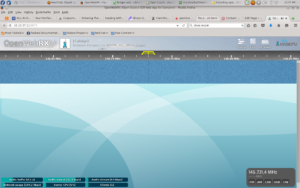I’m a pretty regular viewer of Hak.5. The point still matters. Hak5 Season 19 Episode 16 featured OpenWebRx, a pretty awesome web powered interface for an SDR dongle. I thought it would be useful for monitoring my ham club’s repeater. OpenWebRX is kind of limited in its use cases (to my mind) because of its limited frequency range. It neatly centers about 15 Hz on either side of the set frequency. The author states that its because of the multiuser intentions behind the software. However, that doesn’t mean OpenWebRx still can’t be useful – or fun to play with.
For my use case, I have two purposes:
- General monitoring of my club repeater. Even though I have a baofeng docked and listening, I like the thought of it.
- Another use is to slide down the frequency range touch and be able to test radio microphones without needing another person to phone back – plus I’ll actually be able to hear myself.
While not a flaw of OpenWebRx, the listening range of the SDR is pretty limited – at least with the stock antenna. At present, its not able to hear my club repeater. I’ve picked an adapter from Amazon in the hopes that putting something bigger then a measly 6 inches will pick up my club repeater. After attaching my 1/4 Wave Ground plane, there was noticeable improvement but it was still hard to hear the repeater. Local copies are very strong however, using my 5 watt HT.
There are no install instructions for installing from source in Fedora and there is no package within the Fedora repos. At present, you will have to use the dev branch of openwebrx for the system to run. You’ll see (if you read the ticket) that I promised the developer install instructions for Fedora. The following are the commands I used to get OpenWebRx running on my Fedora 22 headless server.
#OpenWebRx Fedora 22 Install Script(ish)
#Get OpenWebRx dependencies from the repos when possible (assuming you started with the same packages I had - you may need to install Development Tools, among other things. I often install from source.)
su -c "dnf install dh-autoreconf fftw-devel libusb-devel -y"
#Get openwebrx source from github
git clone https://github.com/simonyiszk/openwebrx
cd openwebrx
git checkout dev #and switch to the dev package so it will run on Fedora 22
#Get openwebrx dependencies not provide by the fedora repos
git clone https://github.com/simonyiszk/csdr
cd csdr
git checkout devs #also need the dev version of this
make
cd ..
#need to build rtl-sdr from source - since udev isn't installed apparently by the repos, so .... yup, build from source
git clone git://git.osmocom.org/rtl-sdr.git
cd rtl-sdr
#build guide available from http://sdr.osmocom.org/trac/wiki/rtl-sdr
cd rtl-sdr/
autoreconf -i
./configure
make
su -c "make install && ldconfig && make install-udev-rules"
#openfirewall port since I want to be able to access this from across my lan
firewall-cmd --add-port=8073/tcp --permanent
systemctl firewalld restart
At this point you have to do some configuring to the config_webrx.py file. Go ahead and pop it open in your favorite editor, and add in the required info. One important thing to note, use the local lan address for server_hostname=. Also, note that openwebrx supports opening your server to the world. My DSL won’t support it so I’ve decided to disable that feature for the time being.
To run openwebrx, a simcple chmod +x openwebrx.py && ./openwebrx.py will get you up and going. For running openwebrx unattending, you need to use screen or tmux. Using nohup doesn’t work and creates a mess.
